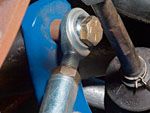
Got a question about your hot rod? Whether it's driveability woes, parts-swapping and interchange advice, help in locating a hard-to-find part, or even off-the-wall theoretical inquiries, we'll cover it here in our virtual garage. I'll answer as many of your questions as will fit in this space. When e-mailing, don't forget to include "Pit Stop" in the subject line, as well as your real full name and hometown or military unit, base, or ship in the message. I'd also like to see quality digital photos of the cars or problems you're working on. And if they're at least 300 dpi at 4 by 4 inches or larger in size, we may throw them in this column as well. -Marlan Davis
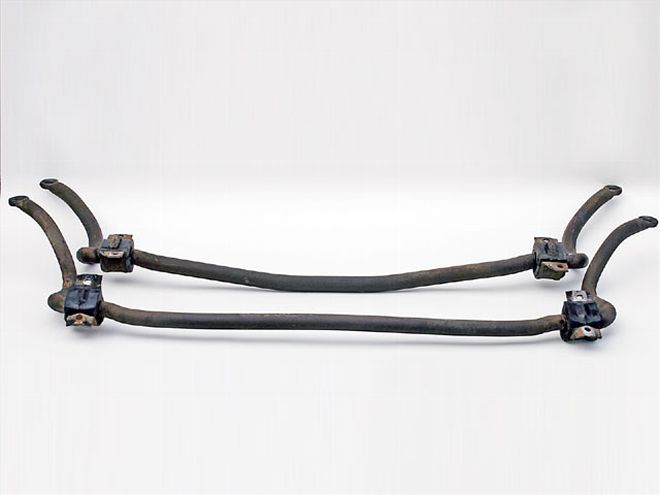 As shown by these bars at Carson Auto Wrecking, compared with the nearly straight G-body bar (bottom), the F-body design (top) adds a slightly curved grin for chassis clearance. Official GM parts books show no interchange between the two, but in reality, the F-body bar fits a G-body just fine-you just can't go the other way and install a G-body bar on an F-car.
As shown by these bars at Carson Auto Wrecking, compared with the nearly straight G-body bar (bottom), the F-body design (top) adds a slightly curved grin for chassis clearance. Official GM parts books show no interchange between the two, but in reality, the F-body bar fits a G-body just fine-you just can't go the other way and install a G-body bar on an F-car.
Antisway Bar Swap
I'm always searching for inexpensive suspension upgrades for my '84 Monte Carlo. I read on a Web site that a 34 or 36mm front antisway bar from an '82-'92 Camaro or Firebird would retrofit onto my car. Is that true? If so, what modifications (if any) have to be done?Nick NigroKansas City, MO
An '82-'92 GM F-car (Camaro/Firebird) production front antisway bar can be installed on a '78-'87 GM G-body (Monte Carlo, Regal, Cutlass, Grand Prix, and so on). GM installed 34 or 36mm hollow antisway bars on some Z28 Camaros and WS6 Trans Ams from '86-'92. By contrast, the largest G-body bar ever offered by GM was a 32mm solid bar. Besides being larger, the hollow bars shave about 8-9 pounds off the frontend. A 32mm solid bar has about the same torsional rigidity as a 34mm hollow bar-so the 36mm hollow bar (GM PN 14094344) would be the stiffest available factory bar offered and a worthwhile upgrade if you can find one. Unfortunately, GM has discontinued all third-generation F-car front bars. Sources for good used 36mm bars include Kirban Performance Products and Carson Auto Wrecking. Installing a 36mm bar requires installing a corresponding 36mm bar-to-frame bushing set, available in polyurethane from Kirban (PN 7111), as well as from Guldstrand Motorsports.
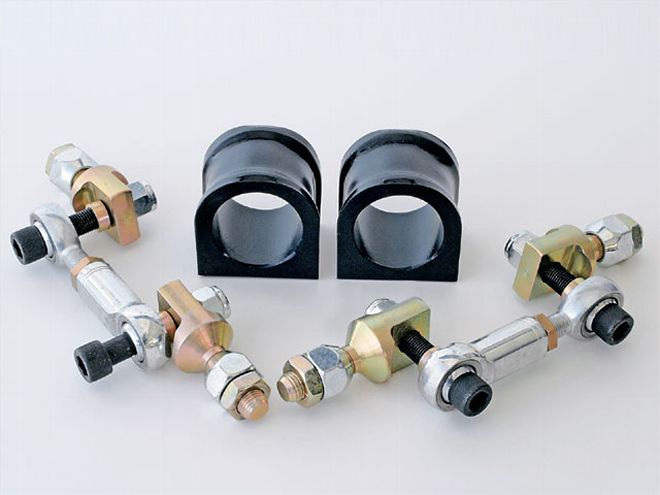 Dedicated antisway bar frame bushings are needed to install the 36mm bar. In Guldstrand's line, the 36mm polyurethane bushings carry PN G01-109Q. They work with the stock factory retention brackets and end links, but the spherical rod-end kit PN A11-209 makes the bar even more effective.
Dedicated antisway bar frame bushings are needed to install the 36mm bar. In Guldstrand's line, the 36mm polyurethane bushings carry PN G01-109Q. They work with the stock factory retention brackets and end links, but the spherical rod-end kit PN A11-209 makes the bar even more effective.
450 HP for '96 Camaro
I just got a '96 Camaro Z28 with a six-speed. It has 86,000 miles on it. The guy I bought it from blew the clutch in three different places. Aside from that, my mechanic says the car is in decent mechanical shape.
I want to push the horsepower and torque up a bit to around the 400-450 range. It's just a toy to beat up on Mustangs on the weekends. I would like to put a turbo on it but don't have $6,000 to spend. This is my first hot rod. Please help get me started in the right direction.
Derek Cobb
Stillwater, OK
The '96 Camaro 5.7L LT1 is rated at 275 hp at 5,000 rpm, with 325 lb-ft of torque at 2,000 rpm. The most cost-effective way to get from there to 450 hp is to add 85 hp or so with some bolt-ons and a cam swap, then get another 100 hp with a mild nitrous-oxide kit. TPI Specialties (TPIS) is a one-stop source for a coordinated combo that should meet your goal.
Start by installing a hotter cam, such as TPIS' ZZ409 grind . With the stock 1.5:1 rockers, it specs out at 0.520/0.520-inch valve lift, 287/287 degrees advertised duration, 239/239 degrees at 0.050, 112-degree lobe separation, and 108-degree intake centerline.
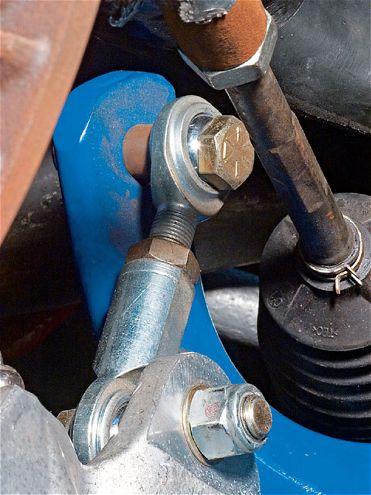 Replacing the stock end links with premium spherical rod ends drastically improves antisway bar effectiveness while eliminating lag. This Guldstrand Motorsports kit is installed on Don Hartman's '99 Corvette SCCA club racer. Rod ends can also be positively adjusted to either eliminate or add preload as desired, serving as another way of weight-jacking the car.
Replacing the stock end links with premium spherical rod ends drastically improves antisway bar effectiveness while eliminating lag. This Guldstrand Motorsports kit is installed on Don Hartman's '99 Corvette SCCA club racer. Rod ends can also be positively adjusted to either eliminate or add preload as desired, serving as another way of weight-jacking the car.
With the increased airflow through the engine, moving up from the stock 48mm throttle body to the TPIS 52mm throttle body is now a worthwhile upgrade. For the exhaust, install long-tube headers (1 3/4-inch primaries x 3-inch collectors) along with dual Random high-flow catalytic converters and a big Y-pipe. These headers are really worth power but have no AIR or EGR provisions. TPIS tests indicate the factory after-cat exhaust system is sufficiently efficient that it is not cost-effective to upgrade it for this combination.
The LT1 ignition is marginal for high-rpm/nitrous applications, so you'll need to boost it with an MSD-6AL ignition and harness to adapt the control box to the LT1 distributor.
Finally, the ZEX jettable 75-125hp dry nitrous system should bring the engine up to 440 or 450 hp. You should still be able to use the stock 24 lb/hr fuel injectors by turning up the fuel pressure as required using an adjustable fuel-pressure regulator. Custom computer reprogramming is required with so many mods, but TPIS can handle that as well.
Collectively, buying all the parts from TPIS, pricing comes out just over $3,000. But you don't have to do everything in one gulp. These mods can be performed in stages as your finances permit.
As for your clutch woes, Centerforce's Dual-Friction clutch and pressure-plate kit (PN DF039020) is more than up to the job. Summit Racing sells it for $569.95.
T-Bird Map To MAF
My car is an '88 Ford Thunderbird sport coupe with a 302 V-8 and the stock computer and emissions equipment. I bought it used and all I've done is put on a set of FlowTech headers with the intention of adding a full exhaust later. I've been told I need to upgrade to a mass airflow meter (MAF sensor) to enable me to further hot-rod it. Is this true? And if it is, what do I have to change to upgrade it?
Richard Brigham
Minerva, OH
Ford EFI systems that use a manifold absolute pressure (MAP) sensor (as your T-bird does) instead of a mass airflow (MAF) meter (like those used on Mustang 5.0-H.O.'s), generally do not tolerate extensive modifications. But exactly how far you can go with a Ford MAP system is somewhat of a gray area. As Ford engine-management expert Jeff Dunne of Dunne-Rite Performance puts it, "Ninety-five percent [of Speed Density owners] can get away with headers, an after-cat exhaust, a larger throttle body, and a cold-air inlet kit; 80 percent do OK with an upper intake from an '89-'93 Mustang; and 50 percent get by with ported heads. Ford Racing's E303 cam isn't supposed to work, but I have found a few guys-less than 5 percent-who got away with it. It seems to just be a matter of random vehicle variations combined with luck."
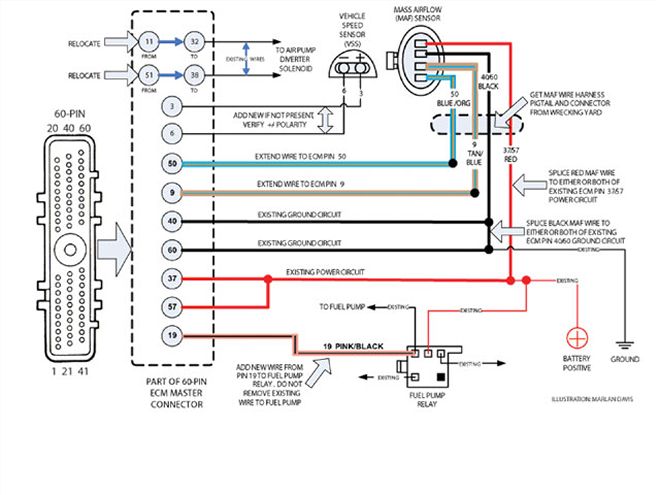 Here's how to modify the T-bird harness to accept a MAF sensor. The 60-pin connector is the main connector going into the computer. As shown in the diagram, add four new wires from the MAF meter to the T-bird harness and ECM, plus an additional wire from the ECM to the fuel-pump relay. Relocate the smog-pump diverter solenoid wires to different pins. Check that your vehicle has a VSS switch (on the trans) and that the wires are correctly hooked up; otherwise, get a VSS out of a Mustang (VSS +/- connector-pin orientation may be opposite from shown).
Here's how to modify the T-bird harness to accept a MAF sensor. The 60-pin connector is the main connector going into the computer. As shown in the diagram, add four new wires from the MAF meter to the T-bird harness and ECM, plus an additional wire from the ECM to the fuel-pump relay. Relocate the smog-pump diverter solenoid wires to different pins. Check that your vehicle has a VSS switch (on the trans) and that the wires are correctly hooked up; otherwise, get a VSS out of a Mustang (VSS +/- connector-pin orientation may be opposite from shown).
That said, for the vast majority, the safe cutoff point would be the Mustang's upper intake (the lower half is the same as the T-bird). The intake swap is worth 10 hp, according to late-model Ford engine-swap expert Mark Sanchez of AEW. Beyond this point, changing over to the Mustang's MAF setup is the safe bet. You will definitely need to change over if the car begins "hunting" at idle, exhibits a significant fuel-mileage decrease, smokes excessively, has trouble pulling a trailer, or just runs erratically. It is not that difficult if you are comfortable troubleshooting electrical wiring and engine-management systems. Sanchez and Dunne provided the following guidelines.
You must change out the computer. Any '89-'93 Mustang 5.0-H.O. SFI computer works. However, the best one for an automatic-trans car is the '89-'92 Mustang auto-trans ECM, batch code A9P (there should be a tag or sticker on the computer). With a stick shift, look for an '89-'90 A9L. You will also need the Mustang MAF sensor (or aftermarket equivalents, like those made by Pro-M, recently acquired by Dunne-Rite Performance), plus the MAF connector and wire pigtail coming off the MAF sensor. The original factory computers are no longer in production, so you are looking at either a remanufactured unit or a salvage-yard takeout. Dunne-Rite is developing a new bolt-in replacement for the Mustang computer that has a USB port so (if necessary) it can be reflashed on a home PC.
Due to overall wiring-harness differences between the Mustang and the T-bird, it is best to retain the T-bird harness, modifying it only to the extent necessary to support the MAF sensor. As shown in the accompanying illustration, some wires in the ECM 60-pin master connector should be relocated to different pin positions, new wires run to pins not currently used, and other wires spliced into existing circuits.
All Speed Density T-birds were manufactured with 14-lb/hr fuel injectors (usually, but not always, identified by their gray body color). The stock Mustang ECM is calibrated for use with 19-lb/hr injectors (typically yellow in color). You will need to move up to at least the 19-lb/hr injectors or (if the vehicle is heavily modified) even larger ones. If a larger injector size than the Mustang H.O.'s stock 19-lb/hr unit is installed, you will also need to install a complementary aftermarket MAF meter that is properly calibrated for the new, larger injector size.
The Speed Density T-bird's ignition firing order is 1-5-4-2-6-3-7-8. This is different from the Mustang 5.0's 1-3-7-2-6-5-4-8. You must retain the T-bird firing order unless the cam is replaced by one with lobes conforming to the Mustang's firing order. However, under no circumstances should you attempt to rewire the fuel-injector wire harness to match the firing order of any retained non-H.O.-style camshaft (keep them hooked up just the way they currently are). At the computer end, the new Mustang ECM will now trigger the injectors according to the Mustang's firing order. Even though the ignition distributor still fires the spark plugs according to the T-bird's firing order, this won't cause any driveability problems. In fact, attempting to reclock the injector wiring only confuses the Mustang computer. The reason for this is that by rewiring the injector harness, you would be transferring the sequential firing order of two fuel injectors from the left side of the engine to the right side (and vice versa). This will not allow the O2 sensors to report an accurate signal back to the computer, resulting in severe driveability problems.
Disconnect the vacuum hose to the MAP sensor but leave the MAP sensor and its wires hooked up. With its vacuum port now open to atmosphere, it will function as a BAP (barometric absolute pressure) sensor, which is needed by the Mustang computer.
Finally, if you have cruise control and it no longer functions properly after the conversion, procure a Mustang Speed Control Amplifier.
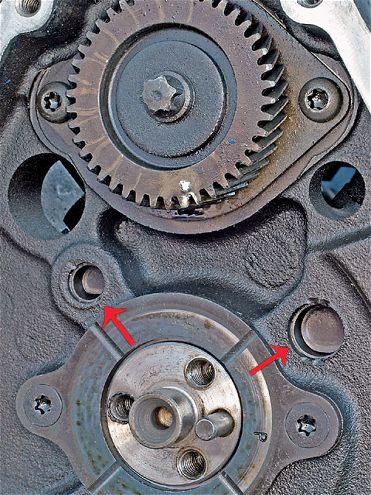 The two-galley V-6 oil system (arrows) is OK through 7,000 rpm. In 1992, V6-90s got a balance shaft (sprocket, top) for smoothness. It creates additional inertial mass, not the plan for a serious hot rod, so delete it and plug any balance-shaft oil-feed holes. Don't avoid '96-and-up balance-shaft motors-most also have true Vortec heads.
The two-galley V-6 oil system (arrows) is OK through 7,000 rpm. In 1992, V6-90s got a balance shaft (sprocket, top) for smoothness. It creates additional inertial mass, not the plan for a serious hot rod, so delete it and plug any balance-shaft oil-feed holes. Don't avoid '96-and-up balance-shaft motors-most also have true Vortec heads.
500HP 4.3L Chevy V-6
I have a 4.3L V-6 Chevy engine. Will 350 Chevy rods and pistons fit in it? How strong is the stock block? Is there a four-bolt main block, or can I use splayed 350 caps? I would like an updated set of heads. Did GM make aluminum heads for this engine?
I saw a 3.75-inch stroker kit for the V-6. Is that a good idea? I also need a single-plane intake. I want to use aluminum rods in this engine to keep rotating weight down. I am going to run 12.5-13:1 compression. I'm not sure of a cam choice yet. I guess I could just cam it like a V-8, but I don't know. I want to turn it 7,000-7,500 rpm and make 500 hp. It is going in an S-10 truck.
Nitrous is a possibility. When nitrous is rated at 200 hp for a V-8, how much is it for a V-6? I am shooting for mid-10s. Think it's possible?
Michael Quesenberry
Leonardtown, MD
Whew-lots of questions here, but let's take it from the top. Chevy's production 4.3L 90-degree V-6 (V6-90) block is physically similar to a same-vintage 350 small-block V-8 with one important exception: the oiling system. Chevy small-block V-8s have three oil galleries above the camshaft. The central gallery feeds the camshaft and crankshaft bearings, while the two side galleries lubricate the lifters and valvetrain. Production V6-90 engines (including the 4.3) have only two oil galleries. The passenger-side gallery feeds the right bank of lifters, just like the small-block V-8. A large-diameter driver-side gallery feeds both the left lifter bank and the camshaft and crankshaft bearings; it is offset from the lifter bore centerline to allow oil to flow around the lifter bodies. The production V6-90 two-gallery oiling system has proven satisfactory through 7,000 rpm. In 1992, GM introduced a balance shaft on 4.3 engines.
All stock-production V6-90 blocks have two-bolt main caps. However, V-8 and V6-90 main caps interchange, permitting V-8-style four-bolt main caps to be installed on the center journals, just like they can be fitted to a two-bolt-main 350 block. New cap installation requires line-boring the block.
GM Performance Parts (GMPP) in the past has offered cast-iron, four-bolt-main, Bow Tie blocks through GM dealer parts departments. Some of these blocks also had full V-8 three-gallery oiling provisions, and depending on the specific part number, could be bored as large as 4.155 inches. Unfortunately, the blocks are no longer available new. Very pricey four-bolt-main, aluminum V6-90 blocks are still available from GMPP. They come set up for dry-sump oiling only and have no mechanical fuel-pump boss. PN 10134371 has standard 350 V-8-sized main journals; PN 10134351 has 400 V-8-sized main journals. They accept a 4.125-inch bore.
All production V6-90 heads are cast iron. Many V6-90s are called Vortec engines by GM, but not all have the good Vortec cylinder heads. The '96-and-up V6-90 head should have the true Vortec-style kidney-bean chamber and vertical intake-manifold bolt pattern. It is essentially the 350 V-8 Vortec head minus one set of ports. According to the Cylinder Head Exchange, look for casting Nos. 772, 140, or 113. There's about a 50/50 chance the 113 heads will be machined for fully adjustable rocker arms; the other casting numbers as well as the remaining 113s come with nonadjustable positive-stop rocker-arm studs. Crane Cams offers an adjustable conversion stud (PN 99148-2, six required), but for serious work, all these should be drilled and tapped for V-8-type screw-in rocker studs and roller rockers.
Brodix sells conventional, 23-degree valve-angle, aluminum V6-90 heads. PN V6-8 is for low-rpm, street-style engines. PN V6-10 is for large-cubic-inch, high-rpm engines. The heads use 2.08/1.60 valves, have 67cc chambers, and accept standard Chevy stud-mounted adjustable rocker arms.
Moving up the food chain, GMPP has offered various incarnations of Bow Tie aluminum heads for these engines, including high-port heads with conventional 23-degree valve angles, Rat motor-like splay-valve heads, and NASCAR-style 18-degree rollover heads. They really work best on 4.125-inch or larger cylinder bores (don't bore a production block more than 0.030-over, to 4.030). At present, only the 18-degree heads are still available new. PN 10143359 is the older part; PN 12480009 features a new design of intake port for the Daytona Dash Racing series. These are serious heads that require Jesel shaft-mount valvetrains (or equivalent) and special pistons that match their competition-style, 43cc combustion chambers.
A production 4.3L V6-90 is a true even-fire engine. Achieving even firing pulses in a V-6 engine with a 90-degree cylinder-bank angle required GM to offset the connecting-rod throws 30 degrees to produce 120 degrees of crankshaft rotation between cylinder firings. Due to the journal offset, V6-90 rods as viewed from the side are narrower than V-8 rods, as are the rod-bearing inserts. V-8 rods and bearings won't work on a production V6-90 even-fire crank. However, most aftermarket forged or billet race cranks use odd-fire cranks with common-pin (nonoffset) crankshaft rod journals. These will accept V-8 rods, although vibrations induced by the odd-fire cranks' uneven firing impulses create considerable vibration on street-driven vehicles (that's not a concern on a race car). Production V6-90 rods are satisfactory for high-perf and limited-production applications if they pass magnetic particle inspection, are properly rebuilt and polished, and are fitted with good ARP bolts. Custom even-fire V6-90 aluminum or steel rods are available from leading aftermarket suppliers. Although original even-fire V6-90 and small-block V-8 pistons have slightly different distances between the inner pin bosses, in practice, aftermarket forged-aluminum V-8 racing pistons can usually be used. Be sure to verify skirt clearance with the offset rod journals during trial assembly.
The distributor and camshaft firing sequence must match the crankshaft (even-fire with offset rod journals or aftermarket common-pin odd-fire). The '92-and-later balance-shaft engines require yet another cam core and unique timing set. MSD offers billet distributors. Some '85 4.3L even-fire V-6 engines with federal emissions had a large-cap HEI distributor that still retained conventional mechanical and vacuum-advance provisions (NAPA remanufactured PN NRD481685, Hollander Salvage Yard Interchange No. 2221).
When it comes to race-type intake manifolds, the two-piece GM cross-ram intake that fit its now-discontinued 23-degree raised-runner aluminum heads is the only one currently available. It won't fit Vortec heads, 18-degree rollover heads, or splay-valve heads. Edelbrock offers V6-90 Performer low-rise dual-planes (PN 2111 for heads with traditional angled bolts or PN 2114 for true Vortec heads with vertical intake-manifold attaching bolts). There is no Performer RPM or Victor Jr.-style intake available. Most V6-90 racers use fabricated sheetmetal intakes.
A 200hp V-8 plate nitrous kit should still make 200 hp on a V-6 because it retains the same jets calibrated with the proper oxygen/fuel/nitrous ratio to maintain 200 hp. In other words, a plate system is a constant mass-flow system. On the other hand, a direct-port nitrous system (each manifold port has its own dedicated nitrous and fuel nozzles) would be down 25 percent on a V-6 compared with a similar V-8 system because it has 25 percent fewer nozzles.
Can a V6-90 be built to run mid-10s? Let's look at the parameters. Figure on your S-10 weighing about 3,000 pounds in race trim (including fuel and driver). With a fairly decent chassis and drivetrain, 500 hp should be sufficient to run 10s. Assuming a 4.030-inch bore x 3.75-inch stroke, you're looking at a 287ci engine (three-quarters of the popular 383 small-block). You'd have to develop 1.74 hp/ci to make 500 hp on 287 ci, mandating a pretty high-level buildup to do it all motor with no power-adders. That also means expensive (and often hard-to-obtain) Bow Tie parts. But with a 150hp nitrous shot, you'd only need to make 350 hp on the motor, about 1.22 hp/ci. That's more reasonable and should be possible using massaged, production-based parts.
So . . . start with a production block. Install V-8 four-bolt main caps and stud the bottom end. The crank would be the stroker you saw, but I'd go with aftermarket steel rods. Aluminum rods have a finite fatigue life and aren't really needed because you won't be revving the snot out of the motor. Use good, aftermarket, forged, custom-made pistons. Install a hydraulic roller camshaft with 235-240 degrees duration at 0.050. You'll already have roller lifters from your good core engine. Comp Cams' Nitrous HP NX288R grind (236/248 degrees at 0.050, 0.520/0.540 valve lift, 113-degree lobe separation) is optimized for nitrous oxide. It would be a custom grind for a V6-90. The exact specs vary slightly, depending on whether the engine is odd- or even-fire, has or doesn't have a balance shaft, and/or if a reduced base circle is needed to clear the stroker crank's rods (another reason for more compact steel rods). The '96-and-later Vortec heads-when mildly pocket-ported and using fully adjustable roller rocker arms-are affordable and up to the task. If you want to splurge, move up to the Brodix aluminum heads, but I'd save my dough for a good sheetmetal Wilson intake manifold and custom headers with 171/48-inch primaries x 3-inch collectors (or even stepped primaries). In any event, feed the engine with a 750 double-pumper carb. That'll get you to around 340-350 hp. Then bolt on a 200hp plate nitrous system and you're there, with a slight cushion.
Another option is to use the 4-71 Roots blower kit from Blower Drive Service or to add a Vortech blow-through centrifugal kit as we did to build a 500hp 4.3; see the story in the Technical Articles archive on www.hotrod.com.
TPIS 450HP PARTS LIST TPIS PN DESCRIPTION COST 100-162 Throttle body, 52mm, '94-'97 F/B-body, includes air foil $280 200-100 Headers, '93-'97 F, uncoated(131/44 x 3, long-tube) 700 700-122 Camshaft, hydraulic roller,grind ZZ409, '95-'97 LT1 375 100-360 Ignition, MSD-6AL 225 100-363 Harness, MSD ignition, singleconnector, '95-'97 LT1 33 200-102 Y-pipe and dual converters for big-tube headers 340 500-400 Nitrous-oxide system, dry (ZEX PN 82018) 585 100-017 Fuel-pressure regulator, adjustable, '94-'97 F/B-body 140 440-400 Custom computer reflash* 350 TOTAL $3,028
*Listed price is a special discount if all other parts are purchased through TPIS. Its normal charge for computer reprogramming is $500.
Where Do I Get . . ....Arias big-block Chevy heads?Brian SmallDoral, FL
Arias hemispherical big-block Chevy heads have returned, and complete crate motors are also available. Contact Nick Arias Jr. Racing Components (Gardena, CA; 310/532-9737; www.nickariasjr.com).
...an adapter plate to mate my '73 Buick TH400 with a 383 small-block Chevy in my '79 Camaro?Andrew LewandowskiLincoln, NE
TCI Automotive (Ashland, MS; 888/776-9834 or 662/224-8972; www.tciauto.com) adapter plate PN 230000 bolts a BOP-style trans to a Chevy block. Another option is an Ultra-Bell bellhousing from J.W. Performance Transmissions (Rockledge, FL; 321/632-6205; www.racewithjw.com). Be aware that the Electra TH400 has a longer extension housing than the standard Camaro/Firebird TH400 extension housing, which could cause driveshaft and floorpan clearance issues.
...a rear bumper cover (or quality reproduction) for my '78 Firebird Formula?Randy McDowellPampa, TX
Classified as a Fascia, Bumper Face (Group 7.831), this part (GM PN 526899) was used on all '76-'78 Firebirds. Neither new GM nor repro units are currently available. Salvage yards typically sell the fascia as part of a complete rear bumper assembly (Hollander Interchange No. 1014-includes the face bar, cover, back bars, brackets, reinforcements, and bumper-mounted lamps, but not any bumper shocks). The '74-'75 rear bumper (Hollander 992) also fits but is not cosmetically identical. Cherry Auto Parts (Toledo, OH; 800/537-8677 or 419/476-7222; http://cherry-auto.proxsoft.com) is an online locating service for good used parts that offers a live search by ZIP Code.
...a book that will tell me what the different Chevy casting numbers are on engine components?Bill MessengerRio Vista, CA
MSA-1 (Pleasant Hill, MO; 800/600-6721; www.msa-1.com) has what you need.
...restoration parts for a '75 Thunderbird?Kelvin McCollamMartin, SD
For N.O.S. and resto parts check out Classique Cars Unlimited (Sumrall, MS; 800/543-8691 [orders] or 601/758-3357 [info]; www.classiquecars.com) and the T-Bird Sanctuary (Sherwood, OR; 800/275-2661 [orders] or 503/692-9848 [info]; www.tbirdsanctuary.com). For used, rust-free body, mechanical, and trim parts, contact Tbird Specialists (Tucson, AZ; 877/797-8634; www.tbirdspecialists.com).